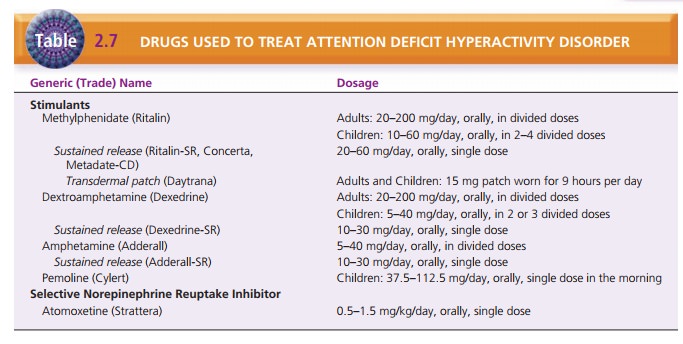Chapter: Psychiatric Mental Health Nursing : Neurobiologic Theories and Psychopharmacology
Stimulants - Psychopharmacology
Stimulants
Stimulant drugs, specifically amphetamines,
were firstused to treat psychiatric disorders in the 1930s for their pronounced
effects of CNS stimulation. In the past, they were used to treat depression and
obesity, but those uses are uncommon in current practice. Dextroamphetamine(Dexedrine)
has been widely abused to produce a high or to remain awake for long periods.
Today, the primary use of stimulants is for ADHD in children and adolescents,
residual attention deficit disorder in adults, and narcolepsy (attacks of
unwanted but irresistible daytime sleepiness that disrupt the person’s life).
The primary stimulant drugs used to treat ADHD are methylphenidate
(Ritalin), amphetamine (Adderall), and dextroamphetamine (Dexedrine). Pemoline
(Cylert) is infrequently used for ADHD because of the potential for liver
problems. Of these drugs, methylphenidate accounts for 90% of the stimulant
medication given to children for ADHD (Stahl, 2006). About 10% to 30% of
clients with ADHD who do not respond adequately to the stimulant medications
have been treated with antidepressants. In 2003, atomoxetine (Strattera), a
selective norepinephrine reuptake inhibitor, was approved for the treatment of
ADHD, becoming the first nonstimulant medication spe-cifically designed and
tested for ADHD.
Mechanism of Action
Amphetamines and methylphenidate are often termed indirectly acting amines because they
act by causing release of the
neurotransmitters (norepinephrine, dopamine, and serotonin) from presynaptic
nerve terminals as opposed to having direct agonist effects on the postsynaptic
receptors. They also block the reuptake of these neurotransmitters.
Methylphenidate produces milder CNS stimulation than amphetamines; pemoline
primarily affects dopamine and therefore has less effect on the sympathetic nervous
system. It was originally thought that the use of methylphenidate and pemoline
to treat ADHD in children produced thereverse effect of most stimulants—a
calming or slowing of activity in the brain. However, this is not the case; the
inhibitory centers in the brain are stimulated, so the child has greater
abilities to filter out distractions and manage his or her own behavior.
Atomoxetine helps to block the reuptake of norepinephrine into neurons, thereby
leaving more of the neurotransmitter in the synapse to help con-vey electrical
impulses in the brain.
![]()
![]()
Dosage
For the treatment of narcolepsy in adults, both dextroam-phetamine
and methylphenidate are given in divided doses totaling 20 to 200 mg/day. The
higher dosages may be needed because adults with narcolepsy develop tolerance
to the stimulants and so require more medication to sustain improvement.
Stimulant medications are also available in sustained-release preparations so
that once-a-day dosing is possible. Tolerance is not seen in persons with ADHD.

The dosages used to treat ADHD in children vary widely depending on
the physician; the age, weight, and behavior of the child; and the tolerance of
the family for the child’s behavior. Table 2.7 lists the usual dosage ranges
for these stimulants. Arrangements must be made for the school nurse or another
authorized adult to administer the stimu-lants to the child at school.
Sustained-released prepara-tions eliminate the need for additional dosing at
school.
Side Effects
The most common side effects of stimulants are anorexia, weight
loss, nausea, and irritability. The client should avoid caffeine, sugar, and
chocolate, which may worsen these symptoms. Less common side effects include
dizziness, dry mouth, blurred vision, and palpitations. The most common
long-term problem with stimulants is the growth and weight suppression that
occurs in some children. This can usually be prevented by taking “drug
holidays” on weekends and holidays or during summer vacation, which helps to
restore normal eating and growth patterns. Atomoxetine can cause decreased
appetite, nausea, vomiting, fatigue, or upset stomach.
Client Teaching
The potential for abuse exists with stimulants, but this is seldom
a problem in children. Taking doses of stimulants after meals may minimize
anorexia and nausea. Caffeine-free beverages are suggested; clients should
avoid chocolate and excessive sugar. Most important is to keep the medication
out of the child’s reach because as little as a 10-day supply can be fatal.
Related Topics